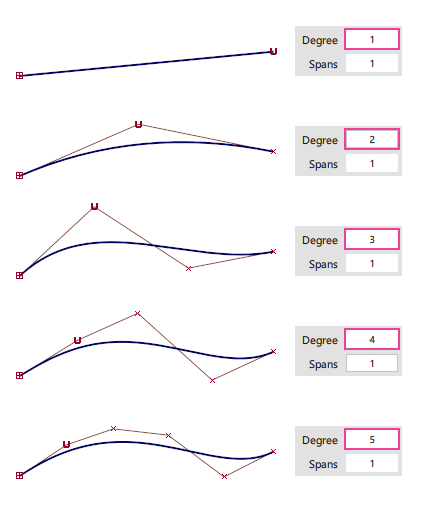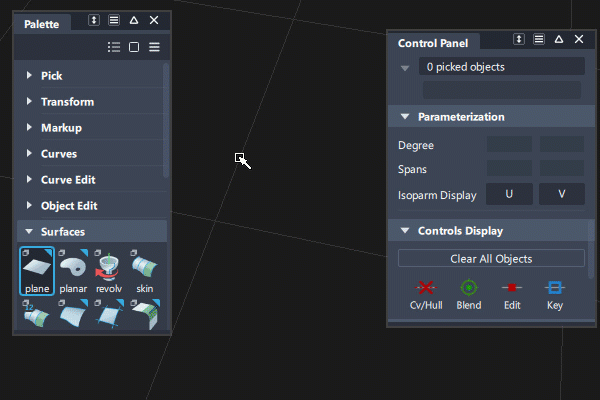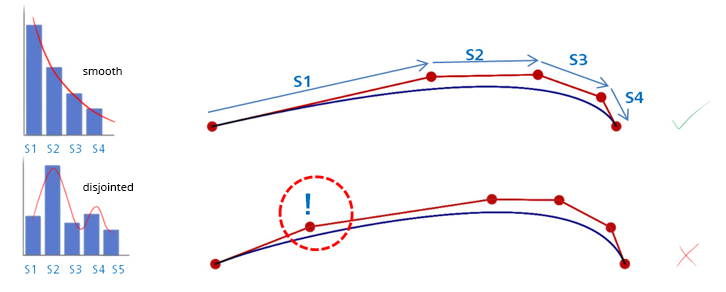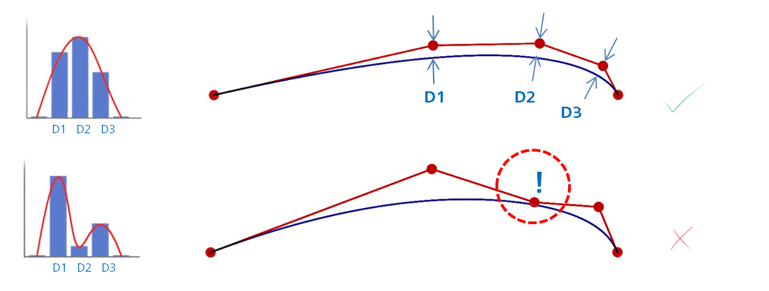CVs, Hulls and Degree
CVs and hulls
Control vertices (CVs) control the shape of curves, surfaces, and subdivision control cages.
A hull is a polygon line that connects a row of consecutive CVs. Hulls illustrate the relationship and flow of CVs and can be used to select a full row of CVs.

Default settings for CVs and hulls:
Vertices are displayed as circles on subdivision cages and as crosses on NURBS curves and surface. This is a user preference and can be changed using Display > Draw Style.
New curves and subdivisions are created with CVs and hulls displayed. New surfaces are not. Use Display > Control to change these preferences.
Degree
Degree is a mathematical property of a curve or surface that determines the number of CVs for each span. Degree does not apply to subdivision control cages.
- The number of CVs in a curve or surface direction = degree + number of spans.
- Higher degree creates more CVs, which allows for a more flexible shape.
- Surfaces can have different degrees across their width and length.
- Some systems use the term "order" for Bezier (single-span NURBS) geometry instead of degree. Order = Degree + 1.

Tools and Workflow

To create a curve by placing CV points:
To display CVs and Hulls:
To select and move CVs and hulls:
- Pick CV
- Pick Hull
- Transform > Move, Scale, Rotate, Non-P Scale
- Transform CV
- Information Window > CV XYZ Location
To modify the degree:
Deep Dive: Degree
Mathematically, degree is the related to the highest power (exponent or index) in the equation used for the curve or surface. The more math in an equation, the more CVs there are in the curve or surface, and so the more flexible it can be.

- Degree 1 curve (single-span) is a straight line.
- Degree 2 curve (single-span) is a planar curve with shape in two dimensions only.
- Degree 3 and above can be shaped in three dimensions.
- The maximum Degree in Alias is 9.
Deep Dive: Flow of CVs and Hulls
Most users judge the flow of CVs and hulls by eye. Below are some guidelines for managing and interpreting the CV layout. The Curve Curvature locator is also useful for interpreting the shape.
- When a hull crosses the curve, there is an inflection where curvature switched from concave to convex.
- CVs should not be on top of one another: co-incident CVs distort the curvature. Use Pick CV with a click (not a drag-select) to display the pick chooser when there are multiple CVs in one location.
- Avoid zig-zags in the hulls. Use Pick walk to step sequentially through CVs to identify co-incidence or zig-zags.
- Use the fewest CVs to achieve the required shape. Unnecessary additional CVs can cause curvature fluctuations and be harder to manage when modifying the shape.

Flow and spacing (hull Length)
The relative spacing between CVs should change smoothly. If we measured the distance between neighboring CVs and plotted that onto a graph, we would expect the values to change in one of the following ways:
- Be constant
- Gradually increase
- Gradually decrease If the values increase and decrease erratically, then this could be described as poor flow.

Flow and distance (CV from curve)
The distance that the CV lies away from the curve should also change smoothly as you travel along the curve.
